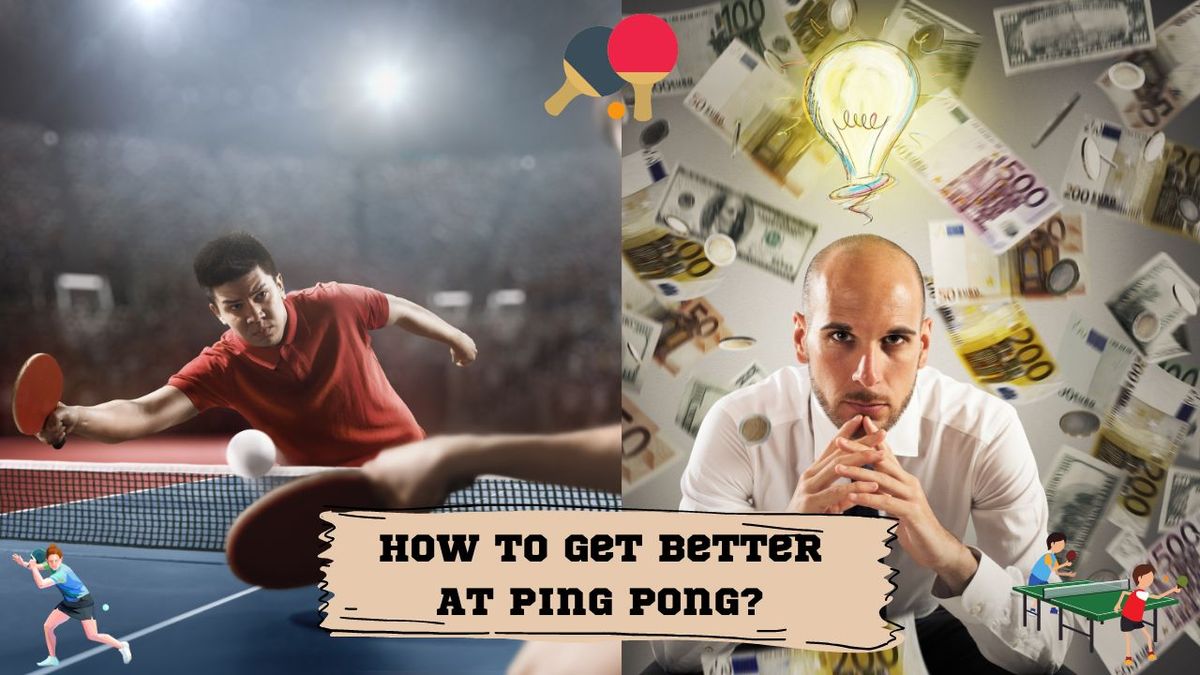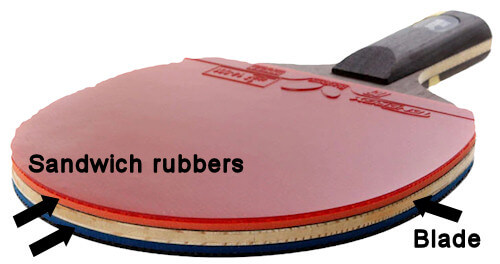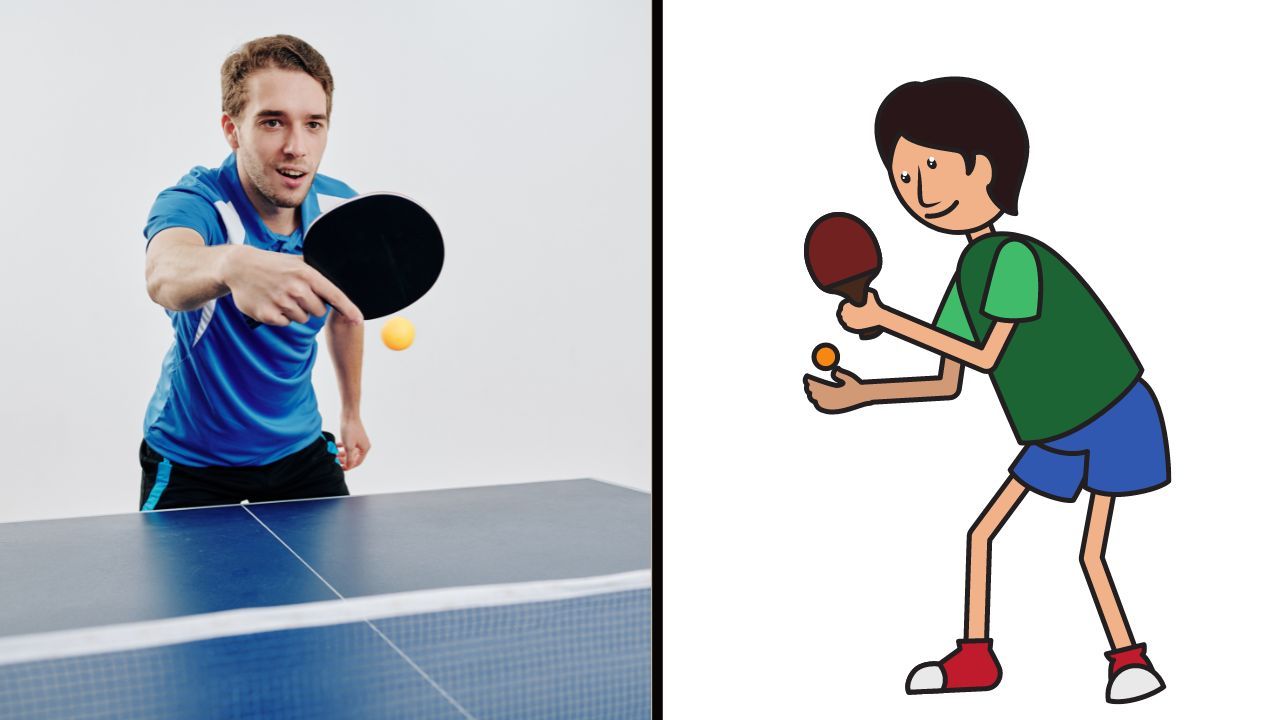How To Get Better At Ping Pong?
Unlock the secrets to ping pong mastery in this comprehensive guide. From mastering spin to perfecting your serves, you'll discover the strategies and techniques that will help you reach new heights in your ping pong game.

Are you tired of seeing your ping pong ball launch into orbit instead of landing gracefully on the table? Ever wondered if your paddle has secretly developed a taste for adventure?
Find a Paddle That Suits Your Game
When purchasing a good table tennis paddle, consider the following key points:

Few Key Points To Look For In A Paddle:
- Choose between an all-wood blade for control or a composite blade for power and speed.
- Determine your playing style—offensive, defensive, or all-around—and select rubber accordingly.
- Opt for a thinner sponge (1.5mm-2.0mm) for more control or a thicker sponge (2.0mm-2.5mm) for increased speed and spin.
- Select a handle grip that suits your comfort and playing style, such as flared, straight, or anatomic.
- Ensure the rubber and blade are approved by the International Table Tennis Federation (ITTF) if you plan to play in official tournaments.
- Research reputable brands and models are known for quality and performance.
- Try out the paddle to assess how it feels in your hand and suits your playing style.
- Gather feedback from experienced players or coaches to make an informed decision.
- Maintain the paddle regularly by cleaning the rubber, protecting it with a cover, and replacing rubber sheets when they wear out.
Start Playing In a Ready Stance
Starting a game of table tennis in a ready stance is crucial for quick and effective movement. Some key points:
- Stand with your feet shoulder-width apart. Position your feet parallel to the side of the table.
- Keep your weight evenly distributed between both feet. Stay balanced, ready to move in any direction.
- Bend your knees slightly to maintain a low center of gravity. This provides stability and allows for quicker movement.
- Face the table with your hips and shoulders parallel to the net.
- Hold your racket with both hands in front of you. The racket should be held near chest level and slightly in front of your body.
- Keep your elbows relaxed and slightly bent. Hold your arms close to your body, allowing for quick reactions.
- Maintain a comfortable grip on the racket handle, such as the shakehand or pen hold grip. Ensure a relaxed grip to maintain wrist flexibility.
- Keep your eyes on your opponent and the ball. Anticipate your opponent's movements and be ready to react.
- Keep your upper body and facial muscles relaxed. Tension can hinder quick and precise movements.
- Be prepared to move quickly in any direction to reach the ball. Stay on the balls of your feet to facilitate swift footwork.
Be ready to move swiftly
Being ready to move swiftly in table tennis is crucial for responding to your opponent's shots effectively.
Anticipate your opponent's shot by watching their body and racket position. Try to read the direction, speed, and spin of the ball based on your opponent's movements. Stay on the balls of your feet, not flat-footed. This allows you to move in any direction quickly.
Maintain good balance by keeping your center of gravity low. Slightly bend your knees to achieve a lower stance, which aids in balance and agility.
Perform a split step, a small jump with both feet, just before your opponent strikes the ball. This helps you react more rapidly and move in the direction of the ball.
Take short, quick steps to move to the ball's anticipated location. Use lateral movements for side-to-side shots and forward/backward steps for deep or short balls.
Be prepared to pivot on one foot and turn your body to reach balls that are out of your initial reach. Practice this maneuver to increase your reach and agility. Keep your muscles relaxed to allow for rapid and precise movements. Tension can slow you down and hinder your ability to reach the ball.
Be flexible in your movements and ready to adjust if your opponent changes the shot's direction, speed, or spin. Incorporate footwork drills into your training routine to improve your agility and ability to move swiftly. Stay mentally focused and prepared to move. Avoid distractions and maintain concentration on the game.
Know Your Fouls
Understanding the fouls in table tennis is essential to play the game fairly and avoid penalties. Here are the key fouls you should be aware of:
- Double Hit:
- It's a foul if you hit the ball twice during a single stroke.
- The point goes to your opponent.
- Obstructing the Ball:
- If you obstruct the ball with any part of your body or clothing, it's considered a foul.
- The point goes to your opponent.
- Failure to Serve Properly:
- When serving, failure to toss the ball at least 6 inches (about 15 centimeters) into the air before striking it is a foul.
- The serve is replayed, and if the error continues, it results in a point for the opponent.
- Failure to Follow Service Rules:
- Violating service rules, such as serving from the wrong location, not having the ball behind the end line, or failing to make the ball visible to the receiver during the serve, is a foul.
- The point goes to the opponent.
- Illegal Contact with the Table:
- Touching the table with your non-playing hand during a rally is a foul.
- The point goes to the opponent.
- Failure to Make a Good Return:
- If you fail to make a good return, such as hitting the ball out of bounds or into the net, it's a foul.
- The point goes to the opponent.
- Hitting the Ball Before It Bounces:
- Hitting the ball before it bounces on your side of the table after the serve is a foul. The point goes to the opponent.
- Failure to Wait for the Opponent's Serve:
- Starting your service motion before your opponent's serve crosses the net is a foul. The point goes to the opponent.
- Unsportsmanlike Conduct:
- Behaviors such as arguing with the umpire, using foul language, or displaying unsportsmanlike conduct can result in warnings, point deductions, or disqualification, depending on the severity.
- Exceeding the Time Limit Between Points:
- Players are allowed a specific amount of time between points to serve or receive. Exceeding this time limit can result in penalties or a point awarded to the opponent.
Practice
Practicing ping pong can be highly beneficial for improving your skills and consistency. Here are some tips to help you improve your game: Start with a training partner or coach. Learn the basics of the game.
- Ball Retrieval Machine: Invest in a ball retrieval machine or robot if possible, which can feed balls to you at varying speeds and spins, simulating game situations.
- Multi-Ball Drills: Use multi-ball drills where you serve several balls to yourself in a sequence, allowing you to work on specific shots, footwork, and reactions.
- Shadow Play: Practice your strokes and footwork by mimicking rallies with an imaginary opponent. This helps improve your muscle memory and movement.
- Serve Practice: Dedicate time to refining your serves, experimenting with different spins and placements. Place targets on the table to improve your accuracy.

- Footwork Drills: Set up cones or markers on the floor to practice specific footwork patterns and movements.
- Table Tennis Training Videos: Watch instructional videos to learn new techniques and strategies, and then try to replicate them in your practice sessions.
- Focus on Weaknesses: Identify your weaknesses and design practice routines that specifically target those areas.
- Conditioning: Incorporate physical conditioning exercises into your routine to improve stamina and agility.
- Consistency and Repetition: Focus on consistent and repetitive practice to build muscle memory and improve your skills over time.
- Mental Practice: Visualize and mentally rehearse your shots, strategies, and game situations during your solo practice sessions.
- Variety: Keep your practice sessions interesting by mixing up drills and exercises to prevent boredom and maintain motivation.
- Record and Analyze: Record your practice sessions to review your technique and identify areas that need improvement.
- Set Goals: Establish specific goals for your practice sessions, whether it's improving a particular stroke or enhancing your overall game.
FAQs
How To Get Better At Ping Pong?
Q: How do you get good at ping pong?
Q: How do beginners get better at ping pong?
Answer: Beginners can improve their skills in ping pong by following a structured approach to learning and practicing the game. Here are some steps and tips to help beginners get better at ping pong:
- Master the Basics:
- Start by learning the fundamental techniques, including the forehand and backhand strokes, grip, and footwork.
- Understand the rules of the game, such as serving, scoring, and basic game tactics.
- Practice Regularly:
- Consistent practice is key to improvement. Set aside dedicated practice time each week to work on your skills.
- Focus on the basics and gradually add more advanced techniques as you progress.
- Work on Footwork:
- Develop good footwork to move around the table efficiently. Practice lateral and diagonal movements.
- Footwork is crucial for reaching the ball quickly and being in the right position to make shots.
- Receive Coaching:
- Consider taking lessons from a qualified coach who can provide personalized guidance and correct your technique.
- Coaches can also teach you game strategies and tactics.
- Play Against Others:
- Play with friends, and family, or at a local club. Regular match play helps you apply what you've learned and adapt to different playing styles.
- Challenge yourself by playing against better players to learn from their techniques.
- Watch and Learn:
- Watch professional ping pong matches to observe how top players move, serve, and execute shots.
- Pay attention to their tactics and strategies.
- Serve and Receive Practice:
- Spend time practicing your serves, including different types of spin serves.
- Work on your return of serve to gain an advantage in rallies.
- Improve Consistency:
- Focus on hitting the ball consistently on the table. Rallying with a partner or a wall can help.
- Reduce unforced errors by improving control and accuracy.
- Study the Spin:
- Understand the importance of spin in table tennis. Practice generating spin on your shots and reading your opponent's spin.
- Stay Relaxed:
- Maintain a relaxed grip and body posture. Tension can hinder your strokes and footwork.
- Set Goals:
- Establish specific goals for your improvement, such as mastering a particular stroke or winning a certain number of points in a match.
- Stay Patient:
- Improvement takes time, so be patient with yourself. Celebrate small achievements along the way.
- Conditioning:
- Improve your physical fitness with exercises that enhance stamina, agility, and core strength.
- Enjoy the Game:
- Most importantly, have fun and enjoy playing ping pong. A positive attitude and enthusiasm for the game can boost your motivation to improve.
Q: How long does it take to become good at ping pong?
Answer: The time it takes to become "good" at ping pong can vary widely from person to person and depends on several factors, including:
- Natural Talent: Some individuals may have a natural aptitude for the sport, allowing them to progress more quickly.
- Previous Experience: If you have prior experience in a similar sport, such as tennis, your learning curve might be shorter.
- Practice Frequency: How often you practice plays a significant role. Regular, focused practice accelerates improvement.
- Quality of Practice: Effective practice involves working on specific skills, analyzing your performance, and seeking feedback. Quality practice is more important than sheer quantity.
- Coaching: Having a coach or mentor can expedite your progress by providing guidance, correcting techniques, and teaching advanced strategies.
- Physical Fitness: Being in good physical shape can enhance your agility, stamina, and overall performance.
- Goals: Your definition of "good" matters. Some may consider reaching a competitive level as "good," while others might aim for recreational excellence. The time required varies accordingly.
- Competition Level: The level of competition you face influences your improvement. Regularly challenging yourself against better players can hasten progress.
Q: What is the most important skill in ping pong?
Answer: The most important skill in ping pong, like in many sports, can be somewhat subjective and may vary depending on your playing style and goals. However, one skill that is often considered crucial for success in table tennis is "Ball Control."
Ball Control encompasses various aspects of the game:
- Consistency: Being able to consistently place the ball on the table during rallies and reducing unforced errors is fundamental. It involves having precise control over your strokes and placement.
- Spin Control: Understanding and applying spin to the ball and also being able to read and react to your opponent's spin is essential for controlling the game.
- Placement: The ability to place the ball where you want it on the table, often aiming for the corners or specific weaknesses in your opponent's game, is a critical aspect of control.
- Recovery and Footwork: Good footwork allows you to quickly move to the right position to control the ball effectively, whether a forehand or backhand shot.
- Adaptability: Being able to adjust your shots and tactics based on your opponent's style and the changing dynamics of the game is crucial.
Key Takeaways!
The path to getting better at ping pong is paved with dedication, practice, and a continuous quest for improvement. By mastering the fundamentals, seeking guidance, and embracing the joy of the game, you can steadily elevate your skills on the table. Remember that progress takes time, so stay patient, keep your focus, and enjoy the rewarding journey of becoming a better ping-pong player.
Articles Worth Checking!
- Unleashing the Ping Pong Game: A Journey into the Heart of Table Tennis
- Ping Pong Balls You Need to Up Your Table Tennis Game!
- Reasons Owning a Ping Pong Table Will Be Your Best Purchase
- Discover the World of Portable Ping Pong On-the-Go Excitement!
- Unleash Your Inner Ping Pong Champion: Exploring the Game's Thrills & Tricks
Our Featured Partner

